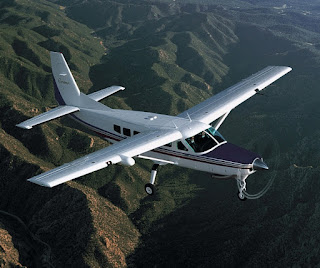The legendary Cessna Caravan (C208 for short) is arguably the most versatile plane ever built. Commuter airline? Sure. Military? 31 different air forces fly them. Island-hopping? Indeed, in the Caribbean, the Hawaiian Islands, the Greek Isles, Indonesia and more. Bush flying? Yep, in the Serengeti, the Australian Outback, the Amazon jungle, you name it. Cargo? Fedex has 239 of them. Air ambulance? Good to go. Arctic Circle in your travel plans? No sweat. If you’re on an Alaskan glacier lake tour, chances are you’re in a Caravan outfitted with floats. And skydive operations routinely rank the Caravan as one of the best jump planes around. The Caravan is the “Swiss Army Knife with Wings,” and you can find them literally all over the world. Fortunately, every once in a while Cessna brings a brand new one to Houston to show it off…

I first got excited about the Caravan a few years ago when I met Chris Rosenfelt (my ATOP B-737 sim partner), who runs Caravan Nation (and its fantastic Instagram page) — he’s dropped countless skydivers out of Caravans and is a huge advocate for the plane. Then over lunch, Cessna’s Derek Moore explained that Cessna was seeing increasing interest in the Caravan as personal transport, with orders for the optional “executive” interior ticking up. About the same time, my email to the legal community announcing my law retirement in favor of flying generated a surprising number of “Can you fly me to out-of-town hearings?” responses. I wondered, could the Caravan serve as an all-in-one charter business and family plane?
I jumped at Derek’s offer to test-fly the Caravan. First, I downloaded and studied Flight Safety’s 298-page Caravan-flying manual. Normally when researching a plane I’d also tinker with its weight-and-balance limitations (i.e. what can it carry and how far?), but that seemed silly here: the Caravan has a whopping 3300-lb. useful load. Even with 4 hours of fuel on board, it’ll launch 7 passengers and their luggage. Basically, if you can fit it in the door, the C208 can carry it. And it has some (four!) sizeable doors.
I met Derek at Sugar Land Airport, and we did a hands-on walk-through of the highlights. The first thing you notice about the Caravan is that it’s BIG — the tarmac shaded by its high, 52’ wingspan was perfect for a preflight chat. And at 14’ tall, it dominates the ramp. The plane’s new — 150 hours on it — and sported the most popular options: a creamy executive interior, purposeful underbelly cargo pod, and 29” (mountain-bike sized!) tires, to name a few.
Time to fly! I climbed the tall steps and slid into the pilot’s seat through the only pilot-specific door I’ve ever used (the co-pilot has his own door). Guiding me from the right seat was Terry Allenbaugh, Cessna’s Caravan guru whose pedigree stretches back to flying C208 serial no. 8 all over Ethiopia in the 1980s. Terry’s colleague Austin Bally and Derek relaxed in the spacious cabin, with Derek helpfully adding C208 bells-and-whistles commentary along the way.
Unlike all the smaller planes I’ve typically flown (except the Piper Meridian), the Caravan is a turboprop: a propeller-driven plane powered not by a piston engine but a turbine, in this case the ultra-reliable 675-hp Pratt & Whitney PT6A. So while the Garmin G1000 panel looked familiar, I welcomed Terry’s advice on the turboprop-specific aspects of the throttle quadrant.
On its simple start-up, the Caravan delivered the sweet whine of a turbine spool-up. No piston catch-and-fire here! A call to Sugar Land ground control, and we were taxing to the runway. After a short take-off briefing, I set the standard 20-degrees of flaps for take-off and advanced the power. Rotation speed is 70kts (70, in this giant bird!) and with nothing more than a slight release of the yoke, the plane flew itself off the runway after an astonishingly short (1500’) ground run. Terry had warned me that all that power required solid right rudder on climb-out, and he was right.
In no time, we were cruising smoothly southwest at 1700’ in this iconic airplane! Under the Caravan’s giant wing, the view from the cockpit is panoramic. No wonder whale-watching, bear-seeking, and safari photo-shooters love this plane.
A smaller craft might have been pushed around by Houston’s summer thermals, but not the Caravan — it’s heft seemed to smooth out the otherwise bumpy air. So too, its robust A/C mocked the soaring mid-August heat. As stout as it is, I expected the C208 to handle ponderously. Not so: it rolled in and out of steep turns surprisingly lightly (although I had to override its envelope protection — with Terry’s permission — to roll it more than 45 degrees). I ignored the Garmin autopilot and hand-flew it the whole time, enjoying every minute. It’s a hoot to fly!

Time to land came too soon, but landing the Caravan was the highlight for me. There’s no need to really flare it — again, Bruce Bohannon’s mantra worked well: “Glide it down, round it out, let it settle, hold it back.” But on touchdown the Caravan’s turbine engine allows a “beta” mode, which basically reverses the propeller pitch to create backwards thrust. So immediately after the wheels were down — again on Terry’s advice — I yanked the power lever from idle to max beta, and a dramatic whoosh signaled the prop was actively slowing us. As a result, our landing roll was over by the first exit on SGR’s Runway 17, 1800’ tops. That’s short field performance! I taxied in with a Caravan-sized grin!

I owe a huge thanks to the Cessna team. I learned a great deal from Terry’s steady guidance. And Derek makes a compelling case for the Caravan. It remains to be seen whether it’s the right plane to take Humphries Aviation to the next level. But, the Caravan’s fun to fly, and it’s good enough for Jimmy Buffett. So it’s a strong contender!






